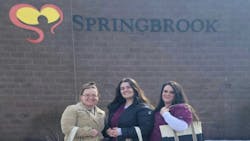From classroom to community: The power of dental hygiene volunteerism
Key Highlights
- Community dental public health initiatives bring oral care and education to underserved and high-need populations.
- Volunteerism empowers dental hygienists to deliver preventive care and oral health instruction where access is limited.
- Dental hygiene education programs should emphasize the value of service through community health courses and volunteer opportunities.
- Experiences like volunteering with children, as this author did, demonstrate how oral health education can foster inclusion and joy.
- Ongoing volunteer engagement helps hygienists expand their professional skills, leadership, and impact on community well-being.
Community dental public health is the foundation for providing resources to populations that need oral health care. Through dental public health efforts, people can access health advocacy—such as the importance of preventing and controlling oral diseases—through organized efforts.1
Although the population is educated about oral diseases, there are several small, specific communities that are unable to receive this same education. With community-focused health efforts, these populations can receive oral health care and oral education through charitable or nonprofit organizations.1-3
Within these communities some groups statistically have poorer oral health due to societal barriers, lack of resources, financial limitations, or physical limitations.1-3 These groups are “populations of need,” meaning exactly how it sounds: groups that require specific interventions to assist with their well-being. An intervention as simple as volunteering can make a huge impact. Since these populations have limited access to oral health care, it’s important for oral health-care professionals to offer their assistance.1-3
Reaching populations of need through volunteer care
Volunteerism provides care for populations in need. If someone is unable to go to the doctor due to a medical impairment or location barrier, oral health-care professionals can bring their knowledge and care to them.4 If someone can’t afford a dental prophylaxis, an oral health professional can volunteer to educate them on how to be more effective with their home care routine. Increased home care prevention can have a major impact on oral disease.1,4
From preschoolers to the elderly, everyone can all greatly benefit from volunteer work. As a new graduate with an educational background in volunteerism, knowing its impact and understanding its importance has increased my drive and aspirations to push for more volunteer opportunities.5
Through my educational journey in hygiene school, I was introduced to valuable insights about volunteering and performing services for the good of others.1 I can reflect on how important volunteering was to our clinical course requirements. We needed volunteers to sit in our patient clinical chairs for approximately three hours. These volunteers understood that we were learning and that the appointment was a lengthy process.
In return, we provided thorough assessments and dental prophylaxis, dental radiographs, fluoride treatments, mouthguards, and sealants at steeply discounted prices. As students we provided positive assistance for those who needed it, and we wanted to make an impact in our community. The dental hygiene school I attended ensures there is an outlet for dental hygiene care, and in return, students thrive in their educational training.
Learning the value of service during dental hygiene education
During our community health course, we were given a plethora of opportunities to volunteer in the community. Although two were required, any additional volunteer services were strictly that: volunteering—no extra credit, no grading system, no requirement.
One volunteer opportunity was at Springbrook.5 Upon learning the goals of Springbrook, I jumped on the opportunity. It’s an organization focused on providing education and opportunities for children with developmental disabilities. I have a deep desire to work with children as they hold a special place in my heart. It was memorable to be given this grand opportunity to help educate Springbrook students during Children’s Dental Health month and provide them with oral health care.
Each child had a bright smile, and laughter filled their classrooms. The children were engaged in all the activities. They hugged us and held our hands as if we had known them their whole lives. The staff offered warm welcomes and treated us as if we were there every day. Springbrook was full of warmth and love, allowing our volunteering to feel even more special.
When our volunteer time was up and we were leaving, I felt a sense of encouragement. Although I have volunteered a few times in the past, there was something different about putting my education to use in new ways. Most assume dental hygienists strictly “clean teeth.” But behind the scenes, we educate patients and promote oral health, which affects our entire bodies, not just the oral cavity.
This experience allowed my peers and me to provide oral health knowledge to the students of Springbrook. I’m fortunate I was enrolled in the dental community health course, and I’m grateful that my dental hygiene program required the course. It prepared me to educate, create goals, and set off on our volunteer adventures and be there for people who needed our services.1-3,5
The course lab highlighted my strengths using technology for lesson planning as well, and I was able to create interactive lesson plans.2 It was rewarding to receive positive feedback from my professor. I’m excited to share my work with more classes during future Children’s Dental Health Months.
Bringing knowledge, compassion, and care to the community
I feel prepared to take on volunteer work in my community and I hope to lead and join more events. Not everyone has easy access to dental care, which is why it is crucial for more dental hygienists to become involved, make an impact, and complete volunteer oral health events to enhance their career!
References
- Nielsen-Nathe C. Dental Public Health and Research: Contemporary Practice for the Dental Hygienist. 4th edition. Boston: Pearson. 2017.
- Oral conditions. Healthy People 2030. 2025. https://odphp.health.gov/healthypeople/objectives-and-data/browse-objectives/oral-conditions
- Healthy people 2030: Oral health. Centers for Disease Control and Prevention. 2025. https://www.cdc.gov/oral-health/php/healthy-people-2030/index.html
- Onofrietti SL. The transformative power of volunteerism: increasing oral health for migrant children, a public health project. RDH magazine. October 4, 2024. https://www.rdhmag.com/career-profession/article/55134985/the-transformative-power-of-volunteerism-increasing-oral-health-for-migrant-childrena-public-health-project
- Pondolfino KL. Educational volunteerism opportunities to assist with personal professional experience. Community Health Lab. Central Region New York Dental Hygienists’ Association, Springbrook Event. February 2025.
About the Author

Alexis Wallan
Alexis was born and raised in Endicott, New York, and is a recently married, soon-to-be dental hygienist. Her experience with volunteerism is extensive, consisting of Girl Scouts, community clean-up events, Thanksgiving giveback missions, and her local church soup kitchen events. Alexis graduated from SUNY Broome Community College in May 2025 with an applied associate’s degree in dental hygiene. She’s looking forward to starting her new career.
